 四川省绿色发展促进会
四川省绿色发展促进会
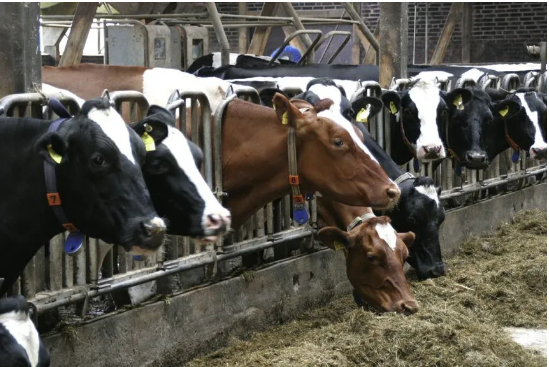
图片来源于网络(侵删)
文章导读
目前,集约化畜牧业生产了全球大部分肉类和乳制品。为满足这种不断增长的需求,集约化农业实践的发展催生了集中式动物饲养场(CAFO),与传统系统相比,这种方式的生产力更高、成本更低。然而,集约化畜牧业在食品安全、动物健康和环境影响方面的引起了人们的担忧。畜牧业需要大量的水,排放大量的温室气体,并且是导致土壤和水体中磷浓度高的养分释放源。以养分污染为重点,畜牧设施有机废物管理不当导致磷释放在很大程度上导致淡水和海水的富营养化,促进有害藻类繁殖。因此,需要发展可持续的农业集约化技术来减少畜牧业对环境的影响。
从技术角度来看,在CAFO中采用营养管理系统可以回收牲畜废物中包含的有价值的成分,包括磷和沼气产品,并减少其环境足迹。但它们的实施必须克服一些管理和经济方面的障碍。因此,制定有效的激励政策以支持畜牧设施的经济可持续性对于成功采用磷回收技术起着至关重要的作用。目前,对从营养回收系统中获得的产品的管理还没有完全制定出来,尽管研究者正在作出重要的努力,以便为磷的循环制定一个全面的管理框架。在此背景下,本文通过牲畜设施养分和能量回收技术的技术经济分析计算框架,系统分析了在CAFO实施磷回收系统的不同激励方案。
原文摘要
在过去的几十年里,畜牧业高度集约化,导致出现了大型集中式动物饲养场。集约化降低了生产成本,但也导致了重大的环境影响。具体而言,来自牲畜废物的营养流失会导致富营养化、有害藻类大量繁殖和缺氧。在CAFO中实施养分回收系统可以减少养分释放和负面的生态系统响应,尽管它们可能会对CAFO的经济绩效产生负面影响。考虑到营养物污染的地理空间脆弱性,我们设计和分析了在CAFO实施磷回收技术的潜在激励政策。案例研究分析选择了美国五大湖地区的2217个CAFO。结果表明,由于规模经济,在最大的CAFO中磷回收在经济上更可行,尽管它们也是最大的富营养化威胁。对于中小型CAFO而言,磷信用额逐步提高养分管理系统的盈利能力。在大多数CAFO中,沼气生产的整合并没有提高磷回收系统的经济绩效,因为它们的规模不够大,无法实现成本效益。通过将养分管理系统的净成本与磷释放产生的负面经济影响进行比较,磷回收被证明具有经济效益。在五大湖地区避免高达20710.3吨/年的磷排放和实现经济中性所需的激励措施估计为2.23亿美元/年。此外,本研究使用纳什分配方案研究了有限激励的公平分配,来确定分配货币资源的盈亏平衡点。

图1 畜牧设施中养分回收系统的选择、大小和评估模型流程图
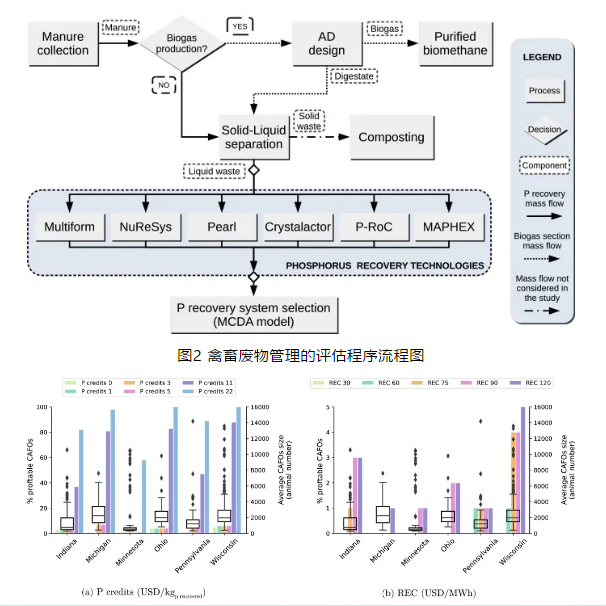
图3 在考虑磷信用额(a)和可再生能源信用额(b)的情况下,在五大湖地区有利可图的磷回收过程
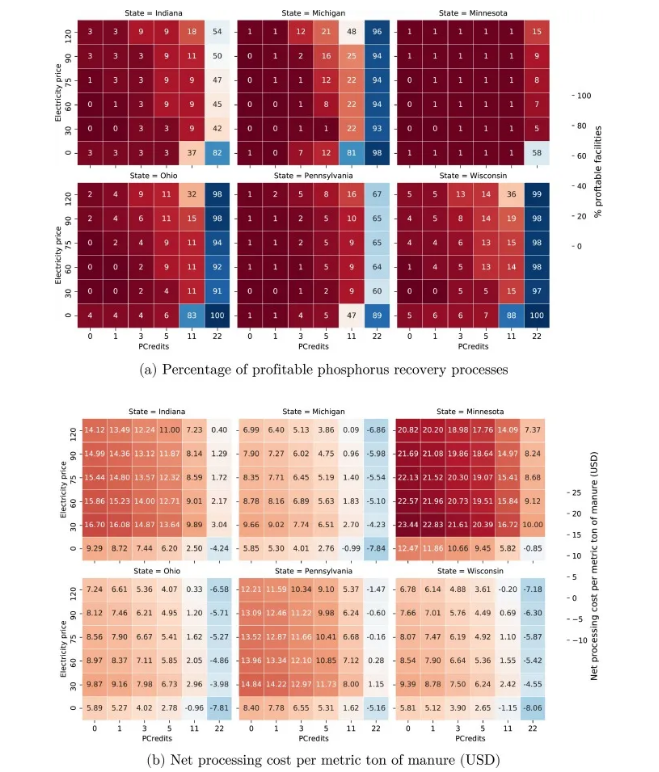
图4 不同激励方案下磷回收过程的经济评价
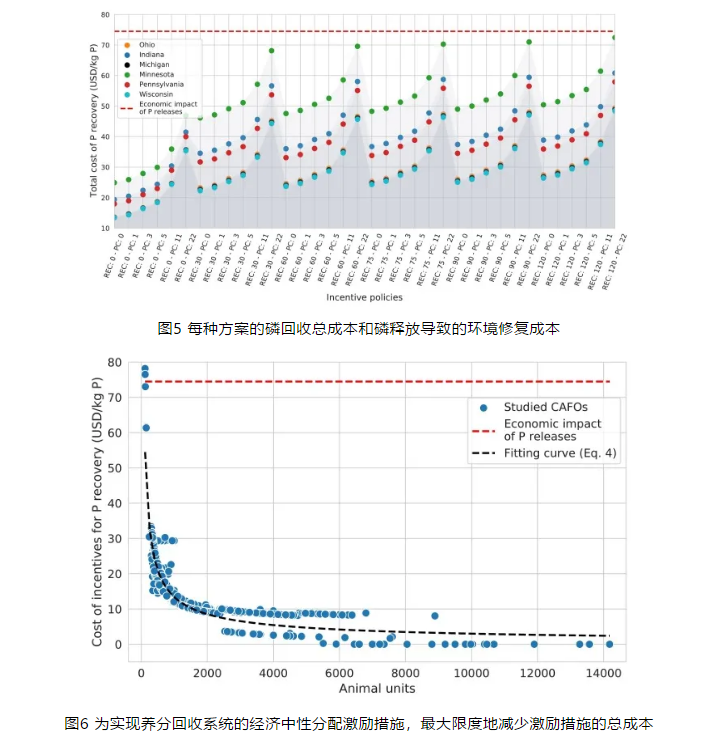
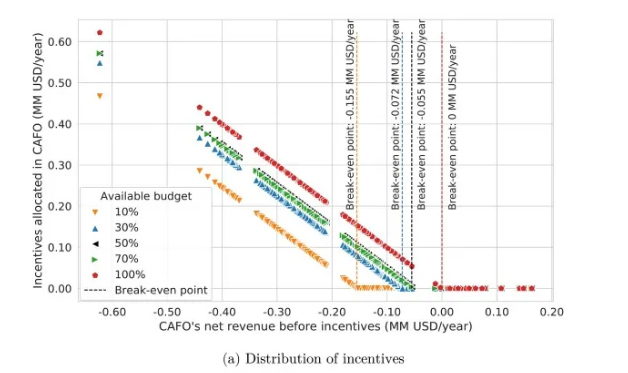
图7 考虑纳什分配方案的激励分配
原文信息

Abstract
Livestock operations have been highly intensified over the last decades, resulting in the advent of large concentrated animal feeding operations (CAFOs). Intensification decreases production costs but also leads to substantial environmental impacts. Specifically, nutrient runoff from livestock waste results in eutrophication, harmful algal blooms, and hypoxia. The implementation of nutrient recovery systems in CAFOs can abate nutrient releases and negative ecosystem responses, although they might negatively affect the economic performance of CAFOs. We design and analyze potential incentive policies for the deployment of phosphorus recovery technologies at CAFOs considering the geospatial vulnerability to nutrient pollution. The case study demonstration consists of 2217 CAFOs in the U.S. Great Lakes area. The results reveal that phosphorus recovery is more economically viable in the largest CAFOs due to economies of scale, although they also represent the largest eutrophication threats. For small and medium-scale CAFOs, phosphorus credits progressively improve the profitability of nutrient management systems. The integration of biogas production does not improve the economic performance of phosphorus recovery systems at most of CAFOs, as they lack enough size to be cost-effective. Phosphorus recovery proves to be economically beneficial by comparing the net costs of nutrient management systems with the negative economic impact derived from phosphorus releases. The incentives necessary for avoiding up to 20.7.103 ton/year phosphorus releases and achieve economic neutrality in the Great Lakes area are estimated at $223 million/year. Additionally, the fair distribution of limited incentives is studied using a Nash allocation scheme, determining the break-even point for allocating monetary resources.